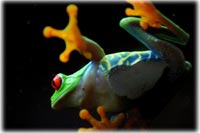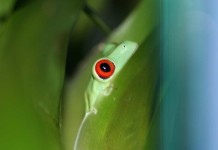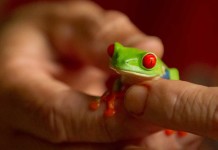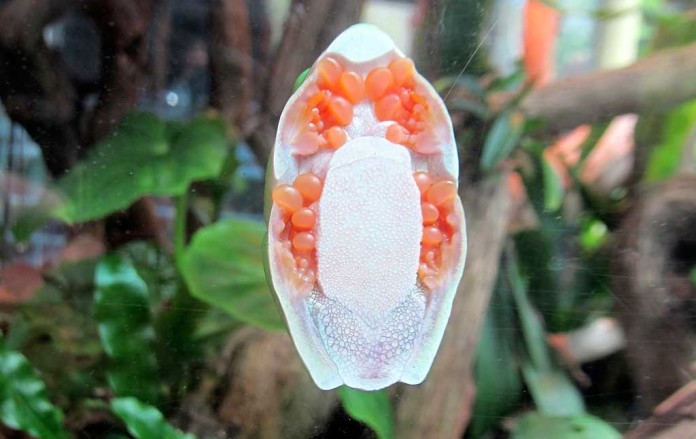Red eyed tree frog feet are not only vibrantly colorful, but they are naturally engineered to allow the frog to grip surfaces. The red eyed tree frog spends most of its life clinging to the underside of leaves in the high treetops. It relies solely on its toe pads to secure itself. Red eyed tree frog feet are part of their startle coloration and provide the adhesive for which they need to cling to surfaces.
The brilliantly colorful red eyed tree frog has vibrant orange feet that have elongated toes. The toes have pads especially made for clinging to surfaces. The frog has four toes on the front and five on the back, giving it a balanced grip on surfaces.
Colorful Defense
Their orange feet are part of their “startle coloration”. This is the method of defense that the frog uses to scare off predators. During the day at rest, the red eyed tree frog tucks its feet under its body and closes its eyes to camouflage itself. When a predator approaches, the frog opens his bright red eyes and uncovers its orange feet to startle the predator. This gains the frog just enough time to escape.
Getting a Grip
 The toe pads are located on the end of each of the frog’s toes and, contrary to what some think, they do not work by suction. The surface of the pad is actually comprised of interlocking cells that are spaced slightly. When the frog lands on a surface and applies pressure to the toe pads, the cells grip the uneven spaces of the surface. The gaps in the interlocking cells drain all but a thin layer of mucus on the pad, therefore creating a powerful friction against the surface.
The toe pads are located on the end of each of the frog’s toes and, contrary to what some think, they do not work by suction. The surface of the pad is actually comprised of interlocking cells that are spaced slightly. When the frog lands on a surface and applies pressure to the toe pads, the cells grip the uneven spaces of the surface. The gaps in the interlocking cells drain all but a thin layer of mucus on the pad, therefore creating a powerful friction against the surface.
The mucus that is contained within the toe pads serves as a very effective adhesive. The red eyed tree frog is not able to grip dry, rough surfaces as well as smooth ones. They cannot produce enough of the adhesive mucus to create a continuous flow of moisture on rougher surfaces.
Red eyed tree frog feet are brilliant in color, have nimble elongated toes and amazing gripping capabilities. They offer the frog defense against predators and are vital for their secure hold on surfaces; especially since the red eyed tree frog spends most of its time hanging on the underside of leafs.














